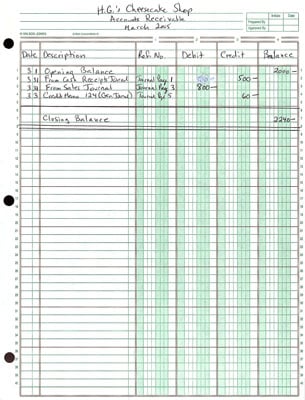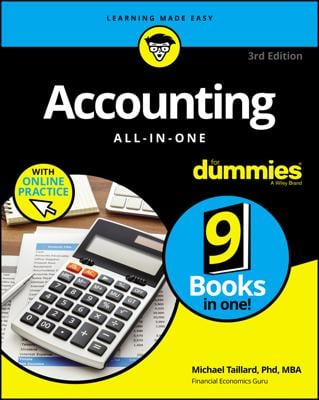The first step in checking accuracy in your accounting journals is summarizing them, which is primarily totaling all the columns in the journal. This summary process gives you totals for the accounts being tracked by each journal.
Summarizing the Accounts Receivable journal
Summarizing the Accounts Receivable journal gives you a grand total of all transactions for that period that involved customer credit accounts. The figure below shows a summary of an Accounts Receivable journal.

The Accounts Receivable journal includes transactions from the Sales journal (where customer purchases on store credit first appear) and the Cash Receipts journal (where customers’ payments toward their store credit accounts first appear) as well as any credit memos for customer returns.
When you summarize the Accounts Receivable journal, you get a closing balance, a balance that shows the total of all financial activity recorded in that journal. The figure shows a closing balance of $2,240, which is the amount outstanding from customers.
Each transaction in the journal should have a reference number next to it, which tells you where the detail for that transaction first appears in the books. You may need to review this information later when you’re proving out the books. When you check for errors in the journal, you may need to review the original source information used to enter some transactions.
In addition to the Accounts Receivable journal, you also have individual journal pages that detail each customer’s purchases on store credit and any payments made toward those purchases. At the end of an accounting period, prepare an aging summary detailing all outstanding customer accounts. This report shows you what money is due from customers and how long it has been due.
For the purpose of proving out the books, the aging report is a quick summary that ensures that the customer accounts information matches what’s in the Accounts Receivable journal. The following table shows what an aging summary would look like for the time period.
| Customer | Current | 31–60 Days | 61–90 Days | >90 Days |
|---|---|---|---|---|
| S. Smith | $300 | |||
| J. Doe | $100 | $300 | $200 | |
| H. Harris | $500 | $240 | ||
| M. Man | $400 | $200 | ||
| Total | $1,300 | $740 | $200 |
In this sample Accounts Receivable Aging Summary, the total amount outstanding from customers matches the balance total in the Accounts Receivable journal. Therefore, all customer accounts have been accurately entered in the books, and the bookkeeper shouldn’t encounter any errors related to customer accounts when running a trial balance.
If you find a difference between the information in your journal and your aging summary, review your customer account transactions to find the problem. An error may be the result of:
Recording a sales transaction without recording the details of that transaction in the customer’s account
Recording a purchase directly into the customer’s account without adding the purchase amount to the Accounts Receivable journal
Recording a customer’s payment in the customer’s account without recording the cash receipt in the Accounts Receivable journal
Recording a customer’s payment in the Accounts Receivable journal without recording the cash receipt in the customer’s account record
Summarizing the Accounts Payable journal
The process of summarizing and closing out the Accounts Payable journal is similar to that of the Accounts Receivable journal. For Accounts Payable, you can prepare an aging summary for your outstanding bills as well. That summary should look something like the following table:
| Vendor | Current | 31–60 Days | 61–90 Days | >90 Days |
|---|---|---|---|---|
| American Bank | $150 | |||
| Carol’s Realty | $800 | |||
| Helen’s Paper Goods | $250 | |||
| Henry’s Bakery Supplies | $500 | |||
| Plates Unlimited | $400 | $200 | ||
| Total | $1,350 | $950 |
The total of outstanding bills on the Accounts Payable Aging Summary should match the total shown on the Accounts Payable journal summary for the accounting period. If yours match, you’re ready for a trial balance. If they don’t, you must figure out the reason for the difference before closing out the Accounts Payable journal. The problem may be the result of:
Recording a bill due in the Accounts Payable journal without recording it in the vendor’s account
Recording a bill due in the vendor’s account without recording it in the Accounts Payable journal
Making a payment to the vendor without recording it in the Accounts Payable journal
Making a payment to the vendor and recording it in the Accounts Payable journal, but neglecting to record it in the vendor’s account
Correct any problems you find before closing out the journal. If you know that you may be working with incorrect data, don’t try to do a trial balance because that balance will contain errors and you won’t be able to generate accurate financial reports.

